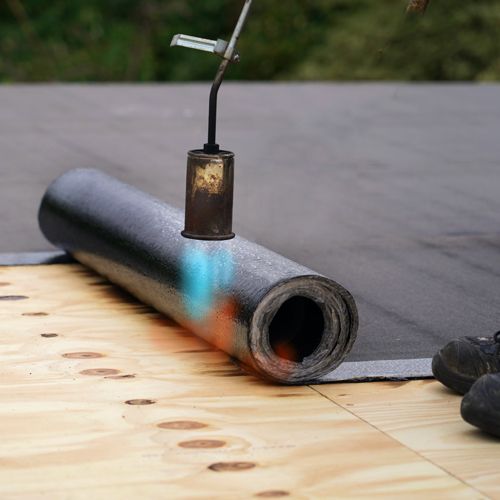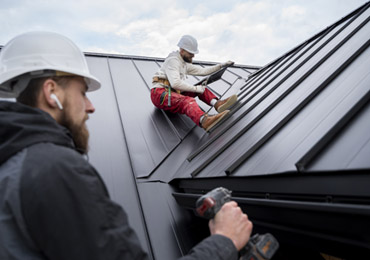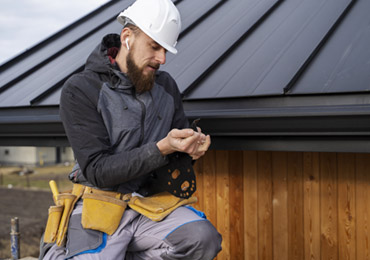Flexability.
We provide complete home renovation services.


Modified bitumen roofing has become one of the most common commercial roofing systems in the industry. Its strength, durability, and relative ease of installation have made it the roofing material choice for millions of projects worldwide.
What is a Modified Bitumen Roofing?
Modified Bitumen Roofing is made of asphalt combined with polymerized rubber or plastic, then reinforced with fiberglass to create a rugged yet flexible waterproof membrane. Modified bitumen roofing is primarily used on flat or low-slope commercial roofs. Depending on the type and material, these membranes may be installed as part of a two-layer system or as part of a multi-ply system
MBR is flexible, weatherproof, asphalt-based, long-lasting, waterproof, reliable, and insulating.
MBR Adheres well, is UV resistant, low in maintenance, easy to install, and reduces energy costs.
Modified bitumen typically comes in membrane form, in rolls that are installed directly onto the substrate via an adhesive. The material may be heat-welded or cold-adhered. Some modified bitumen membranes may also be mechanically attached. Most applications require at least two layers (a base layer and a cap layer), but in some cases, they may be installed in a multi-ply system of three or more layers. The seams are melted together to form a secure bond. They are rated against wind, fire, and hail which means they are resistant to damage during a storm.
There are two sorts of Modified Bitumen: APP and SBS. When expertly installed, either modified bitumen membrane roof can deliver many years of protection against the elements and help keep energy costs low. However, the APP and SBS-modified bitumen membranes are made from different base materials.
Atactic polypropylene (APP) membranes commonly nicknamed “plastic asphalt,” consist of asphalt blended with plasticized polymers that become elastic under high temperatures. APP is resistant to UV rays and is a good choice for structures seeking a “cool roof” effect that fits very much the weather in the Austin and Round Rock area. APP-modified bitumen membranes are generally a type of torch-down roof. In a torch-down roof, the roll roofing layers are laid down and an experienced modified bitumen roof installation specialist employs an open flame to heat the membrane. The hand-held propane torch raises the temperature of the materials until it adheres directly to the underlay and the seams are melded together. The torch-down roofing system delivers a consistent and comprehensively sealed defense against water penetrations, and it also deflects UV rays.
An APP-modified bitumen roofing installation delivers a plastic-like appearance and quality that increases UV ray protection and water removal roof health. The torch-down roofing system utilizes heat at temperatures of 300 degrees or hotter to melt materials and mop across the surface. It remains a preferred choice for smaller areas. An APP torch-down roofing system ranks among the more cost-effective and enjoys a life expectancy of more than 20 years when adequately maintained.
SBS stands for styrene-butadiene-styrene, you can think about SBS roofing as “elastic” or “rubberized” asphalt. This membrane combines asphalt with polymerized rubber for natural flexibility and elasticity. SBS is a good choice for buildings whose roofs expand and contract with extreme temperature changes, as well as roofs subject to higher winds. SBS modified bitumen can be installed as a torch down roof using heat, cold adhesives, or as a self-adhering membrane.
The modified bitumen membrane roof system ranks among the most trusted in terms of water resistance and its ability to withstand damage from extreme weather. Generally speaking, commercial, industrial, and institutional buildings with low-slope roofs are good choices for an SBS-modified bitumen roofing installation. Although widely installed as a torch-down roofing system, other processes can be employed depending on the slope.

A modified bitumen roof offers substantial benefits over other roofing systems.
Here are some of the Modified Bitumen Roof System’s many pros.

Flexability.
Waterproof.
Long Life Span.
Energy-efficient.
Depending on the installation quality and the level of maintenance, Modified Bitumen Roof has an average life expectancy of about 20 years.
Modified bitumen Roof is easy to repair by cutting away the damaged piece of membrane, applying a modified bitumen patch, and applying a sealant to protect it. However, lack of maintenance and care leads to roof leaks that cause water damage. Once rafters and support beams have been compromised, modified bitumen roof replacement may be necessary. It's recommended to schedule annual inspections and make minor repairs as needed.
A Modified Bitumen Roof installation requires skilled roofers. It can cause a potential fire hazard when heat-welded. However, there are new membranes available that don't require a torch.
Cold-applied roofing refers to roof membranes that are attached with a cold-process (water or solvent-based) adhesive rather than by heat welding.
Yes it is. A modified bitumen roofing system can be designed to reflect solar and thermal energy. Sometimes called a “cool roof,” the improved efficiency helps property owners lower HVAC energy consumption. The Modified Bitumen Roofing System is built from highly durable and flexible materials that resist high winds, intense temperature swings, and hailstorms. Modified Bitumen Roofing system is easy to repair from hail damage.
Scheduling an annual inspection with a modified bitumen roofing contractor can identify early warning signs that require minor repairs. This process typically saves tens of thousands of dollars in unnecessary building restoration costs later. We also advise scheduling a flat roof inspection following a high-wind storm or hailstone strike.
If your roof has suffered hail or wind damage, you need a contractor that can perform emergency roof repairs as needed and total installation as well. Modified Bitumen Roof installation requires specialized craftsmanship. Choose contractors that have:
- A license and insurance.
- Experience in installing the same type as yours.
– Experience with insurance companies on damage claims. Press the link for more information.
We at Austin Roofing Company have experienced roofers who will work with you every step of the way, wether it is fixing a damaged roof, or tearing down a damaged roof, and installing a new one.


Subscribe to our newsletter and get update in your inbox.
© All Copyright 2024 by ARC - Austin Roofing Company